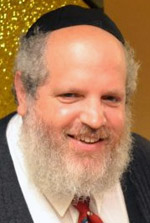VaYikra
By Rabbi Yeruchem Eilfort

CARLSBAD, California — This week we begin the third of the Five Books of Moses, the Book of Leviticus, known in Hebrew as VaYikra. The portion begins by G-d calling to Moses, inviting him to enter the newly-completed Tabernacle, also known as the Tent of Meeting. The purpose of this meeting was so that the Almighty could explain the array of sacrifices that the Jewish people were commanded to bring for numerous different reasons. For instance there was one type of sacrifice brought for sins, another for peace offerings (to offer thanks), daily communal sacrifices, special sacrifices for Shabbat and Holidays, and many other reasons as well.
The fact that this portion and Book of the Torah come third, meaning in the middle of the Five Books, and since it begins with the letter Vav, which means ‘And’, thusly connecting it the previous Books of the Torah, is an indication that this Book is the central theme of the Torah. These sacrifices are what it is all about.
Lest anyone make a mistake it behooves us to understand the sacrificial service. The idea that one can sin and then sacrifice an animal in his place to make things ‘all better’ is absolutely false. Rather, we know that the animal that was sacrificed represented the inner animal each of us contends with, as we all have appetites and tendencies that are not G-dly. We harness our animalistic behaviors so that they may be used in the service of G-d instead of only serving ourselves, and we have thereby elevated a part of ourselves. We have revealed G-dliness where before there was only mundanity. When someone brought his or her sacrifice, in order for it to be effective it had to be brought with the right intent, known as Kavanah in Hebrew. Then, and only then, did the desired transformation of the individual take place.
G-d determined upon a system that was meant to reveal the profound connection between the Creator and His choicest creation; humanity. When conveying these laws to Moses, G-d first invited Moses to ‘meet’ with Him. Our Sages tell us that is what is indicated by the use of the word VaYikra, and in fact was the method G-d used whenever He was going to communicate with Moses – He didn’t just start communicating. This is a term of endearment, as G-d Almighty loved communicating with His beloved Moses.
The great commentator Rashi contrasts this with a similar word that was used when G-d communicated with the evil Bilaam – who sought to curse and destroy the Jewish people. Regarding Bilaam the Torah states that VaYakar, which means, “And He happened upon.” The way described indicates that it was almost like happenstance, and there was something akin to a measure of embarrassment for the Creator in His ‘meeting’ with Bilaam.
One of Bilaam’s many flaws was his tremendous arrogance. In this regard he was the polar opposite of our hero Moses. Moses, in fact, was so humbled by his personal invitation to speak with G-d, that our Sages tell us, he used a small Alef at the end of VaYikra to demonstrate that he was humbled by the fact that G-d spoke to and through him.
Incidentally, Alef, the first letter of the Hebrew alphabet, is quite instructive. Alef is connected to the word Alufo, which means The Chief (a reference to the Creator). We can also learn from the way the Alef is comprised, it has a Yud at the top, a Yud at the bottom, which are connected by a line. The Yud on top represents G-d, whose name begins with a Yud. The Yud at the bottom represents the Jewish people, whose name (Yisroel or Yehudi) begin with a Yud. And the line connecting G-d above and us below is the Torah and its commandments, and/or our faith in G-d.
May we continue to look to our great Moses as an example for all of us! May we continue to be mindful that the Torah and Mitzvot, which he brought to us, are our lifeline and connection to G-d!
Shabbat Shalom!
*
Rabbi Yeruchem Eilfort is Director of Coastal Chabads and Chabad at La Costa. Rabbi Eilfort welcomes readers’ comments and questions and may be reached at RabbiE@ChabadatLaCosta.com.